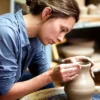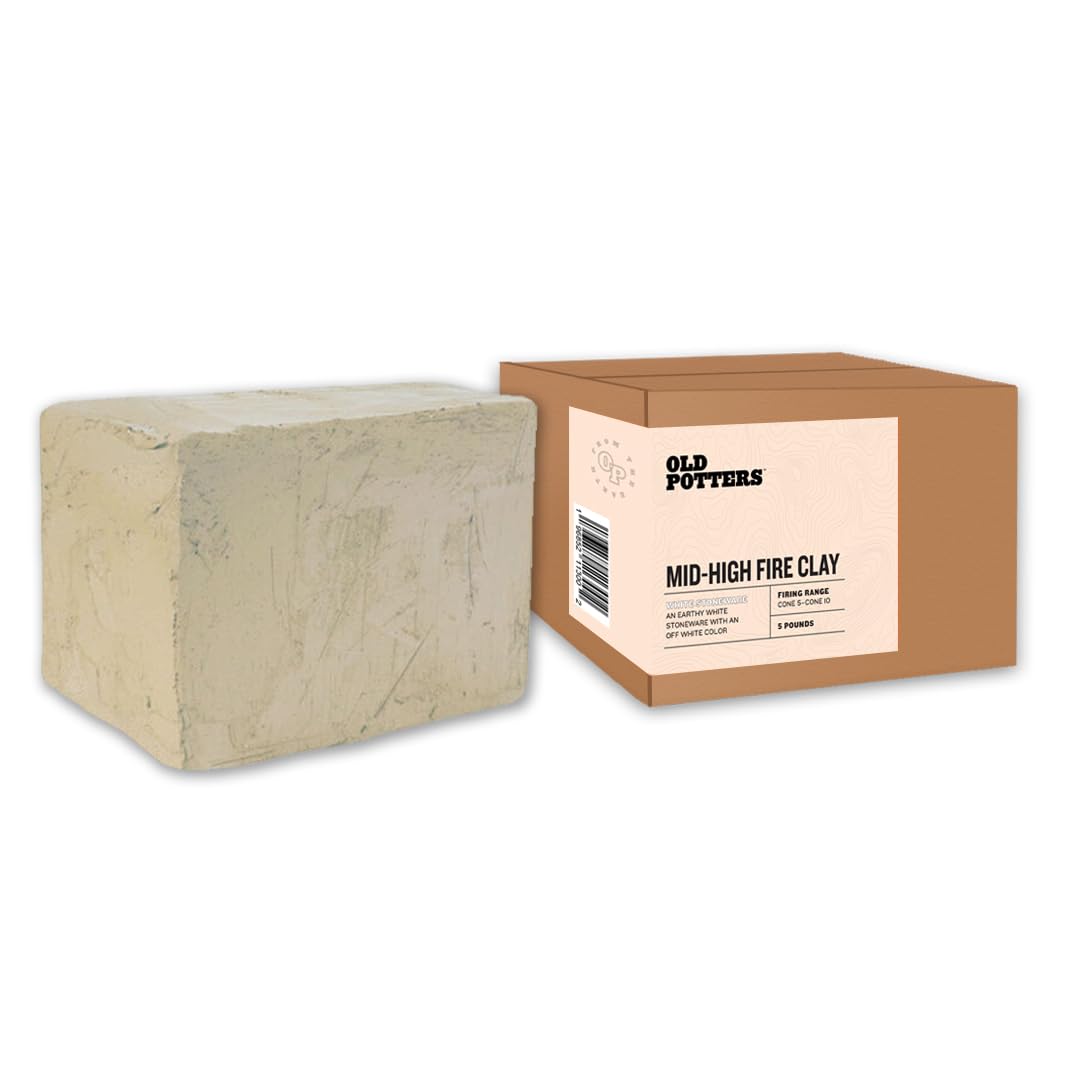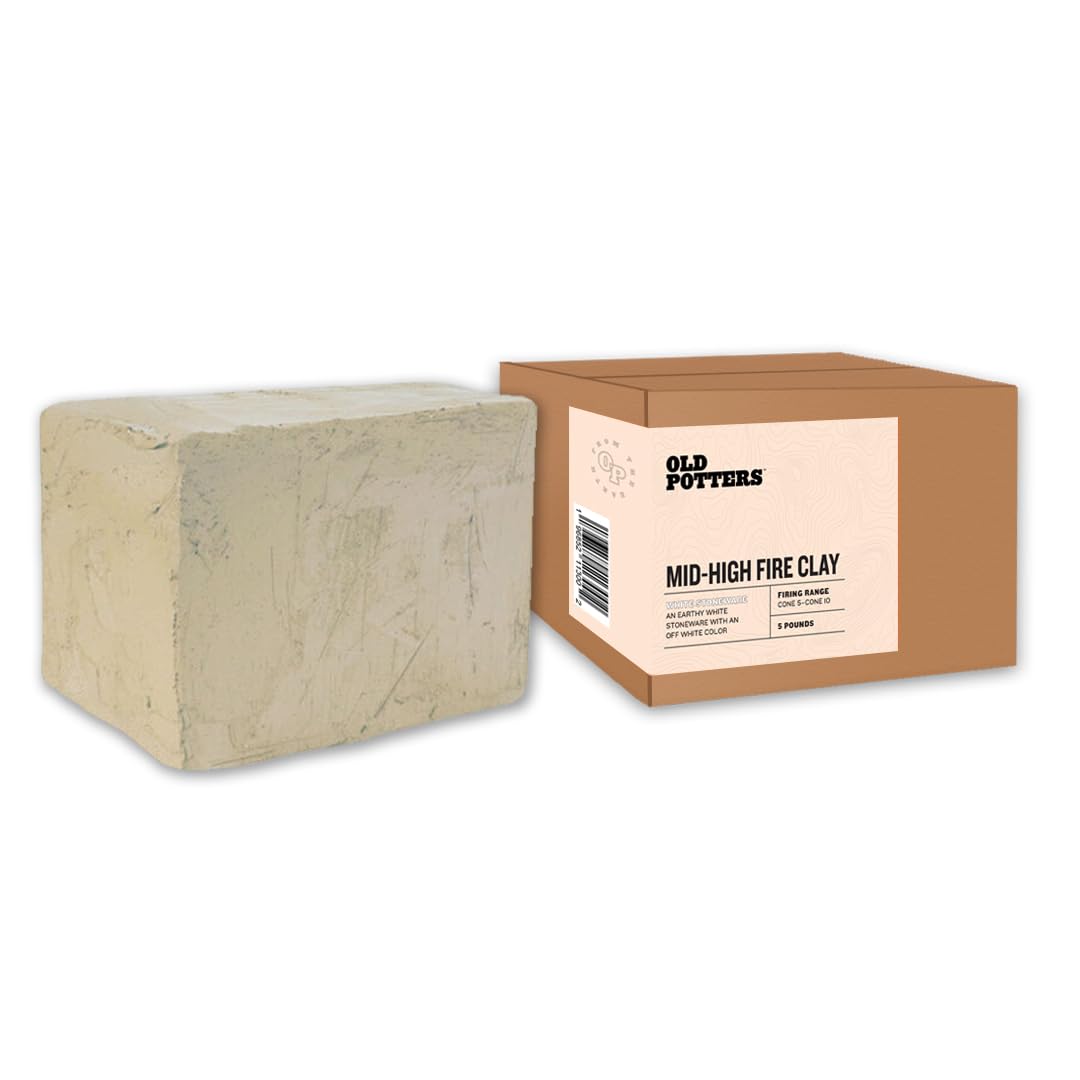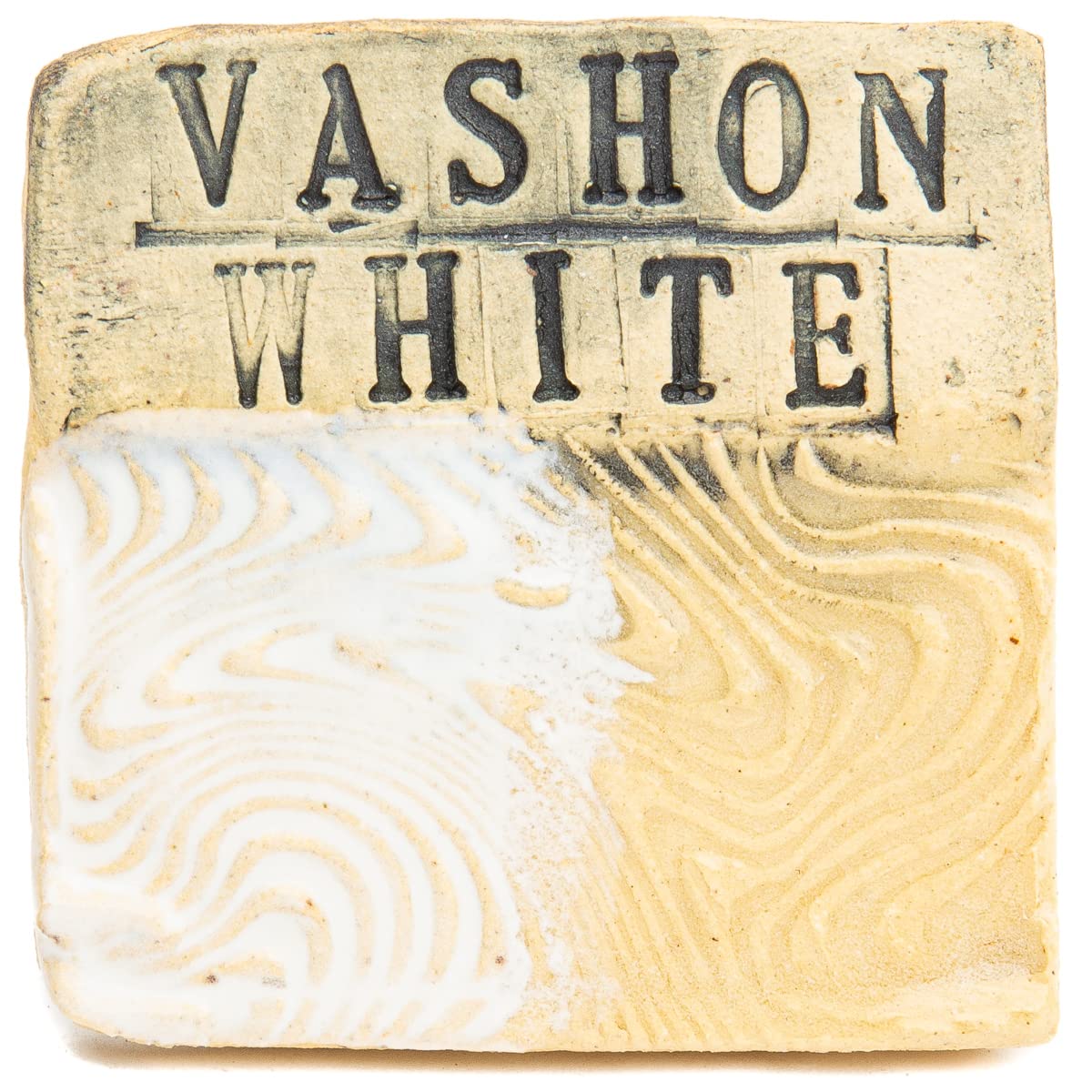White stoneware has become a staple in the pottery world.
Potters praise its versatility and aesthetic appeal.
This material is highly favored for its durability and the clean, classic appearance it lends to finished pieces.
Whether crafting elegant dinnerware or decorative art, potters appreciate white stoneware for its ability to maintain a strong structure while allowing for a range of glazes and finishes.
When selecting the best white stoneware for pottery, there are key factors to consider.
The texture and plasticity of the clay are crucial for ease of shaping and detail.
Firing temperature is another important consideration, as it affects the final strength and color of the pottery.
Ensuring the stoneware is free from harmful chemicals like lead is essential for functional pieces intended for everyday use.
The best white stoneware offers a smooth texture that is easy to work with and has high plasticity, making it suitable for both hand-building and wheel throwing.
It should possess good thermal shock resistance and vitrify well at its recommended firing temperature to ensure durability.
We spent a significant amount of time researching and testing various white stonewares to identify the ones that deliver exceptional results for both beginners and experienced potters.
Top White Stoneware for Pottery
We’re excited to share our curated list of the top white stoneware options for pottery enthusiasts.
Our selection is based on quality, durability, and usability, ensuring you find the perfect material for your creative projects.
Old Potters Mid High Fire White Stoneware
This clay offers excellent flexibility and durability, making it an ideal choice for both beginners and seasoned potters.
- Smooth and easy to manipulate
- Holds its shape well during wheel throwing
- Versatile for different pottery techniques
- May require additional wedging for consistency
- Not ideal for low-fire projects
- Can be tricky for complete beginners without guidance
Old Potters’ Mid High Fire White Stoneware is a great companion in our pottery projects, offering a smooth and reliable texture.
With its flexibility, we’ve found it perfect for wheel throwing, while still holding up under various hand-building techniques.
It’s a versatile clay that can cater to different pottery styles.
Stability is one of its strengths, as it maintains shape without making a lot of slip during the wheel process.
It’s suitable for craftsmen of all ages, making it an excellent choice for art teachers and students alike.
We’ve discovered that storing it properly avoids drying out, extending its usability.
Although it’s designed for a mid to high firing range, some users might find the need to wedge it more than expected.
Beginners might face challenges in using it right away due to its requirements, but with practice, it serves well in diverse artistic endeavors.
All in all, this clay remains a valuable staple for anyone keen on pottery.
Old Potters Low Fire Modeling Clay
This clay is an excellent choice for both beginners and experienced potters who seek easy-to-work-with material for their creative projects.
- High plasticity and smooth texture make it easy to shape.
- Suitable for various skill levels, from novices to experts.
- Made in the USA from organic, non-toxic materials.
- May require additional grog to prevent cracking.
- Somewhat expensive compared to other options.
- Potentially holds air pockets that need careful handling before firing
We’ve recently spent some time molding with Old Potters Low Fire Modeling Clay and found this white stoneware incredibly accommodating for various pottery techniques.
Its ease of use on the wheel and during hand building makes it a favorite in our workshop.
The clay stays moist for an extended period, which helps maintain flexibility and smoothness.
One of the standout features is its versatility.
Perfect for throwing, hand-building, or sculpting unique designs, it adapts well to multiple pottery styles.
While centered on our wheel, it remained soft, allowing precise formation of pottery pieces.
Additionally, its readiness out of the package saves preparation time, making it ideal for spontaneous crafting sessions.
We’ve noticed a slight tendency to crack during firing if not properly conditioned, hence we recommend adding some grog to improve durability.
Aside from that, Old Potters’ low fire clay is excellent for producing professional-looking artwork.
It’s a bit pricier than some other clays, but the quality justifies the investment, especially for those serious about pottery.
Vashon White Stoneware Clay
This clay is a fantastic choice for potters looking to enhance their work with stability and a creamy white finish.
- Perfect for both beginners and experienced potters due to its ease of use.
- The grog adds stability, making it ideal for large projects.
- Fires to a beautiful creamy off-white, enhancing glaze colors.
- May dry quickly if not stored properly due to grog content.
- Some find the grog too coarse for fine wheel throwing.
- Requires glazing or painting as it may vitrify with a pinkish hue.
We’ve had the pleasure of crafting with the Vashon White Stoneware Clay, and it’s impressed us with its versatility.
Its ease of handling stands out, making it suitable for beginners and seasoned artists alike.
The grog content provides added rigidity, a boon for larger sculptures requiring robust support.
When fired, this clay transforms into a soft, creamy off-white.
It’s a striking backdrop that makes colored glazes appear vibrant and alive.
Whether working on functional or decorative pottery, the results with this clay are consistently pleasing.
However, its rapid drying nature due to the grog can catch you off guard, so ensuring you have the right storage solutions is key.
While its groggy texture might be problematic for precision work on the wheel, it excels in hand-building techniques.
Tiles, slabs, and sculptures can benefit from the added strength.
For those seeking a clay that offers both durability and aesthetic potential, we find the Vashon White a noteworthy option.
Deouss White Stoneware Clay
This versatile and smooth clay is perfect for both beginners and seasoned potters looking for reliable results.
- Excellent plasticity allows for easy shaping.
- Compatible with multiple firing methods.
- Suitable for a variety of techniques, enhancing creative options.
- May require extra wedging to achieve perfect consistency.
- Slightly more effort needed for intricate details.
- Price might be on the higher side for larger projects
Trying out the Deouss White Stoneware Clay was a pleasant experience.
Its smooth texture made it a breeze to mold and shape, especially for hand-building and sculpting projects.
We noticed it worked exceptionally well across different crafting methods, providing us with flexible options to explore our creativity.
The clay also offered a reassuring level of plasticity, retaining its form throughout the crafting process without cracking.
It’s particularly valued for its adaptability in both low and high firing situations, allowing us to achieve brilliant finishes.
The low iron content in the clay helped minimize interaction with glazes, keeping our pottery pieces pristine and clean.
On the downside, the consistency required a bit more care when prepping, which might involve additional wedging time.
We found this necessary for achieving the best results, especially if the work involved detailed sculpture or intricate shapes.
Nevertheless, once we got the hang of it, the clay proved its worth in creating stunning pottery.
The initial investment seems justified for those invested in quality crafting experiences.
SIO-2 PRAI White Stoneware
This pottery clay offers versatility and quality performance, perfect for potters looking to create exceptional pieces.
- Provides excellent smoothness and plasticity.
- Suitable for a range of firing temperatures.
- Enhances glaze adherence and appearance.
- Contains a considerable amount of grog.
- Requires careful handling to avoid waste.
- May not be ideal for beginners without guidance
We recently had the pleasure of working with the SIO-2 PRAI White Stoneware and found it to be an excellent choice for both wheel-throwing and hand-building techniques.
Its remarkable smoothness makes it incredibly easy to shape and mold, ensuring our creative ideas can be realized effortlessly.
The consistency and stability during handling make it a reliable option from start to finish.
Firing this clay at high temperatures opens up a wide array of artistic possibilities.
The versatility to handle a range of firing temperatures from Cone 6 to 10 is impressive, allowing us to achieve outstanding results with glazes.
It not only holds its shape well during the firing process but also enhances the vibrancy and depth of the glazes applied.
However, the clay’s inclusion of 40% impalpable grog could be overwhelming for those new to the medium.
It does require some caution in its initial handling, making it more suitable for those with some experience.
Buying Guide
When we select white stoneware, there are several critical features to consider. Texture is paramount.
We should look for stoneware that is smooth and moldable.
This makes the crafting process easier and more enjoyable.
We should also consider the firing temperature.
White stoneware can vary in terms of the heat it can withstand.
Check if the stoneware suits the kiln temperature available to us.
Plasticity is essential for shaping.
Higher plasticity stoneware allows for better molding and shaping without cracks.
It’s ideal for detailed pieces.
The color after firing can vary.
Some remain pure white, while others might gain a tint.
Knowing what finish is desired ensures satisfaction with the final product.
Here’s a quick overview:
| Feature | What to Look for |
|---|---|
| Texture | Smooth and moldable |
| Firing Temp | Matches kiln limits |
| Plasticity | High for easy shaping |
| Color | Desired post-firing hue |
The particle size of the clay should not be overlooked.
Good particle distribution can affect the clay’s strength and plasticity.
It’s also valuable to check the density.
A denser stoneware will usually be more robust and can withstand more wear and tear, which is perfect for functional pottery.
Weight is another factor.
Lightweight stoneware is easier to handle and shape.
Yet, ensure it’s not compromising on the durability.
Finally, we need to be aware of the availability of the stoneware.
Ensuring a consistent supply can prevent disruptions in our pottery projects.
Frequently Asked Questions
When choosing white stoneware for pottery, it’s important to consider the specific characteristics that make it stand out, such as its durability, firing temperature, and workability.
We explore recommended types for different firing needs and specific uses, like wheel throwing, while also discussing glazing techniques.
What are the characteristics of the best white stoneware for pottery?
The best white stoneware offers a smooth texture that is easy to work with and has high plasticity, making it suitable for both hand-building and wheel throwing.
It should possess good thermal shock resistance and vitrify well at its recommended firing temperature to ensure durability.
How does white stoneware differ from other types of clay in pottery?
White stoneware typically has a higher silicate content, giving it a lighter color and finer texture compared to other clays like earthenware or porcelain.
It generally fires at a mid-range temperature and combines the strength of stoneware with a more refined appearance, suitable for both functional and decorative pieces.
What are the recommended white stoneware clays for cone 6 firing?
For cone 6 firing, we recommend looking for stoneware clays that are formulated for mid-range firing and provide good strength and consistency.
Popular choices include B-Mix, which offers a smooth finish, and other brands that specifically label their products as suitable for cone 6.
Which white stoneware is preferred by potters for wheel throwing?
Potters often prefer white stoneware that is specifically formulated for wheel throwing, such as clays that have fine grog to enhance workability while maintaining smoothness.
Clays like B-Mix and porcelainous stoneware blends are popular because they combine ease of shaping with reliable performance during firing.
What are the best practices for glazing white stoneware ceramics?
When glazing white stoneware, it’s crucial to consider the interaction between the glaze and the clay body.
Ensure that the glaze has a compatible expansion rate to prevent crazing or shivering.
Also, applying even coats and testing different glaze combinations can help achieve the desired finish.
Are there any white stoneware options that can be fired without a kiln?
Traditional stoneware requires a kiln to reach maturation temperatures.
However, you can use air-dry clays that mimic the appearance of white stoneware.
These clays do not have the durability of kiln-fired stoneware, but they offer a practical alternative for non-functional, decorative pieces.







